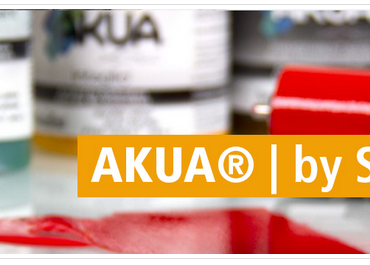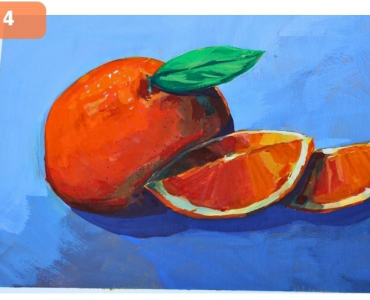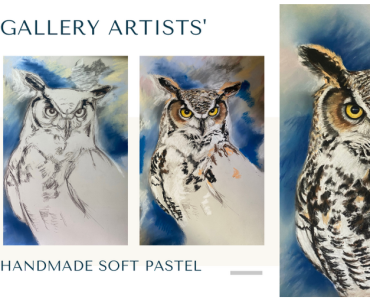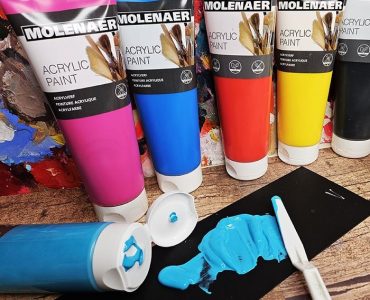This time I’ve been playing with Jaxon Aquarell Watercolours!
“I’ve been using an Aquarell set consisting of 48 half pans, which gives an excellent colour range including metallics and whites, and you also get two really good sized open-out palettes for mixing. They come in a black metal tin which is tough enough to cope with many days spent in muddy fields, but compact enough to fit in the bag I carry all my stuff around in.
I should say that I’m fussy about watercolours, well about all materials actually…but watercolours can be incredibly disappointing and frustrating if they don’t deliver a really good pigment load. These are terrific, and offer great quality pigments, and good value too.
The colours are notably intense, and they handle well too, both with very little dilution and also when made into really wet washes.
Jaxon Aquarell Watercolours flow beautifully as you will find high quality Gum Arabic binders in them. When you use them ‘just slaked’ with little water you get that intense luminous effect, which you really want to achieve with watercolours.
A quick note about Gum Arabic:
Gum Arabic is a binder used in watercolours to hold the pigment particles together and also to help the paint adhere well to the paper support. It’s called:
- Gum Arabic: traditionally sourced across the Middle East, Sudan, Senegal and Somalia.
- Acacia Gum: it comes from the Acacia Tree
When a high quality Gum Arabic is used the watercolours develop a luminous appearance as the water evaporates and the paint dries on the paper.
The samples below demonstrate the strength and vibrancy of Aquarell colours, which stand up extremely well to overlaying; creating rich textures, patterns and colour variations.
There are so many different techniques to try with watercolours which actually can be an exciting, innovative and experimental medium… why don’t you use the following samples as a guide and inspiration and give some of these techniques a try!
All these samples are on Gerstaecker No3 Watercolour paper
Above:
- L.H Top: Clean water dropped onto rich colour washes, while still wet.
- R.H Top: Strong wash applied as a resist over white oil pastel.
- L.H Mid: Strong colour applied onto wet paint to create mottled effect.
- R.H Mid: Washes of colour with spray of clean water
- L.H Bottom: Strong colour applied in lines of changing thickness to create ‘Cross-hatching’
- R.H Bottom: ‘Hatching’ and ‘Feathering’
Above: On the left you can see salt resist techniques; in the top one the salt has been sprinkled onto damp paint, and in the bottom onto wet paint….the result is softer and more subtle on damp paint, and stronger and more speckled on wet-both are good for creating gritty, speckled textures.
You can also see experiments with dropping colour onto damp paper and paper primed with washes of colour…it’s really worth practising these effects and noting the differences so you can use them in your work.
Jo’s Top Tips:
- Always keep your water clean when working with watercolours. It really is the only way to keep your colours bright and fresh-I tend to have at least 2, and often 4 pots of water on the go at once.
- Put together your own travel kit in a waterproof and wipeable bag-if your kit is ready to go. It makes it so much easier to maximise your opportunities to draw and paint. Exactly what goes in the kit is personal, but this list might get you started: Sketchbook with hard cover, watercolour set, cotton buds for absorbing excess paint and making small corrections, pencils, artist pens like the Faber Castell Pit Artist pens ( I find black, sepia and grey versions especially useful), small water container and some brushes and or some reservoir brushes https://www.greatart.co.uk/search?q=water+reservoir+brushes, paper towels, putty eraser, glue stick for attaching small found items- I don’t usually bother with scissors but tear instead and a Molotow masking pen.
To read the full blog, with further techniques and effects to try and Jo’s finished pieces, plus a useful materials list, please visit www.joyorkart.co.uk
All images are © Jo York www.joyorkart.co.uk
Find all Jo’s posts published in GreatArt online Magazine by clicking here!
Discover Jaxon full range available online at www.greatart.co.uk/jaxon and in-store.
GreatArt – your art superstore
Art supplies, ideas and advice for all techniques.
GreatArt offers you art supplies for all techniques from:
- traditional fine art painting,
- drawing,
- sculpture
- printmaking,
- graphic art,
- illustration,
- airbrushing,
- model making…
We offer an extensive range of stretched canvas and display products for exhibition, all the art supplies required to create your own bespoke canvases, as well as custom framing and mounting services from GreatArt Store. You’ll also find hundreds of articles and tutorials to browse in the online magazine.





















Very interesting and informative…. Thank you Jo.
I‘ve been desperately searching for more reviews of these watercolours. Now I have just ordered the 12 half pan set as my first watercolours and I’m really excited. I will definitely give the techniques you showed a try. Thank youu ! 🙂
Is there any pigment/light fastness information for these watercolours?
You can find the lightfastness ratings on the product page for each colour: https://www.greatart.co.uk/jaxon-fine-artist-watercolours.html
The majority of the range has the highest rating of 3 stars.
Proper pigment details would be much more useful to me as a long time painter; they’d tell me exactly what I’m getting in the case of generic colour names like ‘permanent red’ as well as what I might expect behaviour wise from a particular paint eg. granulation. I’ve also had one too many bad experiences with paints with no pigment info (only some kind of light fastness given) that turn out to be dye based that it’s hard to trust unknown brands.